

Technology and Webb’s Depth of Knowledge « SBBC. Most educators are more familiar with Bloom’s Taxonomy than with Webb’s Depth of Knowledge.
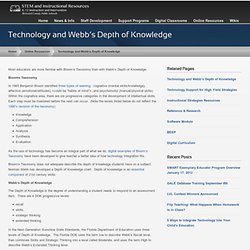
Blooms Taxonomy In 1965 Benjamin Bloom identified three types of learning: cognative (mental skills/knowledge), affective (emotional/attitudes) <could be “habits of mind”>, and psychomotor (manual/physical skills) Within the cognative area, there are six progressive categories in the development of intellectual skills. Each step must be mastered before the next can occur. (Note the levels listed below do not reflect the 1990’s revision of the taxonomy) KnowledgeComprehensionApplicationAnalysisSynthesisEvaluation As the use of technology has become an integral part of what we do, digital examples of Bloom’s Taxonomy have been developed to give teacher a better idea of how technology integration fits.
Bloom’s Taxonomy does not adequate describe the depth of knowledge students have on a subject. Flipping Blooms Taxonomy. Teacher Shelley Wright is on leave from her classroom, working with teachers in a half-dozen high schools to promote inquiry and connected learning.
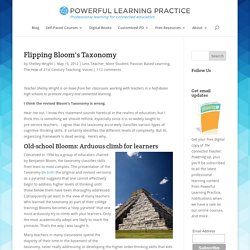
I think the revised Bloom’s Taxonomy is wrong. Hear me out. I know this statement sounds heretical in the realms of education, but I think this is something we should rethink, especially since it is so widely taught to pre-service teachers. I agree that the taxonomy accurately classifies various types of cognitive thinking skills. It certainly identifies the different levels of complexity. Old-school Blooms: Arduous climb for learners Conceived in 1956 by a group of educators chaired by Benjamin Bloom, the taxonomy classifies skills from least to most complex.
Many teachers in many classrooms spend the majority of their time in the basement of the taxonomy, never really addressing or developing the higher order thinking skills that kids need to develop. Here’s what I propose. Blooms 21: Let’s put Creating at the forefront. Differentiation - tools, tips and resources. Differentiation is an important aspect of education.

Students learn differently, have different needs, different backgrounds, different skills, different ability levels, different interests and more. As educators, we try to create engaging lesson activities that provide a variety of learning experiences and allow students to demonstrate their learning in different ways. Differentiation should occur in both how students learn and gain knowledge and skills, and in how they demonstrate and are assessed on what they have learned. “In the practice of education, differentiation is defined as working to address the abilities, interests, and needs (both perceived and real) of individuals. THE DAILY RIFF - Be Smarter. About Education. Clearinghouse.
E-Newsletter SignUp Show all resources sorted by most popular most recent most popular first containing Join to rate and submit resources ← Previous Page 1 of 58 Next → (1 ratings) interactive programs for making and analyzing art.
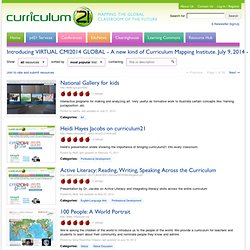
Posted by cweihe, last updated on July 21, 2012 Categories: Art (3 ratings) Heidi's presentation slides showing the importance of bringing curriculum21 into every classroom. Web Tools / General Web Tools. Web 2.0 describes the way the internet is used today.
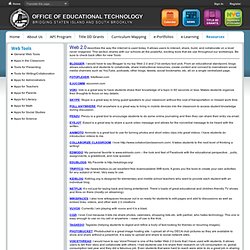
It allows users to interact, share, build, and collaborate on a level never imagined. This section shares with our schools all the powerful, exciting tools that we use throughout our workshops. Be sure to check back often for new Tools BLOGGER: I would have to say Blogger is my top Web 2.0 and 21st century tool pick.
Researchers Evaluate Tech.-Oriented, Personalized Learning. Published Online: March 14, 2011 Published in Print: March 17, 2011, as Researchers Tackle Personalized Learning But determining what works is proving to be challenging The Digital Learning Council, a group formed by a pair of former governors—Republican Jeb Bush of Florida and Democrat Bob Wise of West Virginia—released a report in December calling on schools to do a better job using digital tools to personalize learning.

The nation’s largest educational technology conference, ISTE 2010 in Denver last June, was packed with sessions about how technology tools can be used to play to students’ strengths and weaknesses. Prominent virtual schools are riding the personalization bandwagon, too, touting the use of digital tools to customize education. But the question most educators ask is: Does this tech-driven personalized approach work? For starters, “personalization” in education can involve so many different approaches that it’s hard to define in a universal way. Tracking Clues Richard E. - The How's, Why's and Value of Educational Technology. 0 Comments January 18, 2012 By: David Andrade, Jan 18 Written by: 1/18/2012 2:46 PM ShareThis Educational Technology - it's a term that technically can mean anything from a pen or overhead to laptops and interactive web 2.0 technologies.
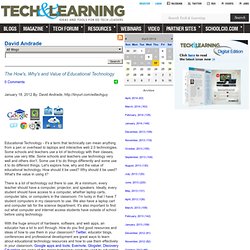
There is a lot of technology out there to use. With the huge amount of hardware, software, and web apps, an educator has a lot to sort through. The lesson objectives always come first. I do a lot of projects. Technology is also a great communication tool. Technology can also be used to differentiate teaching and learning. I have also used technology for backup plans, to communicate lessons when I'm absent, and to save my back.
Backup plans are extremely important as a teacher. I have had a couple of extended absences due to illness, injury, or serving on a jury, over the last 10 years. I have a serious back injury from working as a Paramedic. Money and budgets are a huge issue right now in education. Research/Information - the internet ('nuff said) Launching an iPad 1-to-1 Program: A Primer. Schools Use Digital Tools to Customize Education. APPitic - 1,300+ EDUapps. Home.